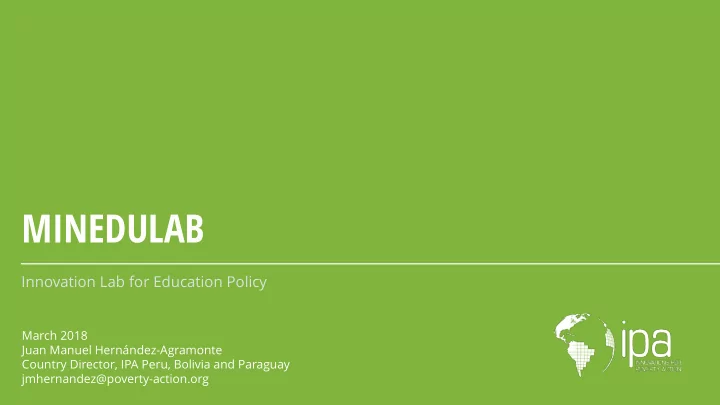

MINEDULAB Innovation Lab for Education Policy March 2018 Juan Manuel Hernández-Agramonte Country Director, IPA Peru, Bolivia and Paraguay jmhernandez@poverty-action.org
MORE EVIDENCE MOREIMPACT Policies where cost-effectiveness is proven with rigorous evidence can have large social returns on investment.
How do randomized evaluations work? 1. The group we are looking at is divided randomly in two 2. One group receives the program or intervention 3. Outcomes for both groups are measured for impact
How can we institutionalize the creation and use of rigorous evidence within government institutions?
Outline • What is MineduLAB? • Examples • Design and implementation • Key factors for success • Challenges • Next steps
MineduLAB Innovation lab for education policy nested inside the Ministry of Education of Peru Allows Ministry to improve education and management outcomes with innovative policies Designs, rigorously evaluates, and implements low-cost improvements of existing policies or new interventions
Learning Cycle Idea for a new program Use of evidence generated to incorporate learnings Problem identification and diagnosis Scale-up of effective programs Contextualization of existing evidence Experimental evaluation Innovation and evaluation design Innovation implementation 8
Institutional positioning Team embedded in the Evaluation Secretary of Strategic Panning Provides M&E and budgeting services to implementation units M&E MineduLAB Centralization of information: Access to Ministry’s Secretary of Strategic administrative data Planning Control over budget: Capacity to Monitoring “persuade” units within the Budget ministry
Research support and translation MineduLAB Team creates partnerships Team between academics and implementation units following learning cycle The team is composed of evaluation professionals trained on RCTs Intermediates/translates Implementing interaction between academics Unit + and implementation units Researchers
Cost-effective innovation The lab uses administrative data for evaluation and low cost interventions Large quantity of administrative data Heavy focus on tweaks to existing policies and incorporation on behavioral economics
Policy and academic relevance Working at the intersection of two MineduLAB decision making sets of incentives: process guarantees innovation’s policy and academic relevance MineduLAB team creates Novel evidence Timely evidence that has impact that has impact demand by dissemination on scientific on political workshops and internal-external progress priorities call for proposals. Innovations are selected by the Secretariat team with advisory from the board of academics.
Impact Minedulab completes the learning cycle Supports implementation units on decision making based on results Supports implementation unit on implementing innovation Disseminates learnings by publishing and presenting results (public goods)
Current MineduLAB Projects
Innovations with results Innovations in evaluation phase Booklets with Text Messages to “Grow your Videos sharing the Text Messages Non-monetary comparable information improve school Mind” financial benefits of to motivate incentives for on results of similar Management secondary and higher teachers teachers schools education School Principal, School Principal Students Parents and Students Teachers Teachers Teachers and Parents Innovations in design or implementation phase Access to Increase the Feedback on Information to technology for visibility of schools’ key outstanding teaching teacher indicators students purposes absenteeism Parents and School Principal, Teachers and Parents Teachers Students Teachers and Parents
Videos to reduce school dropout: Preliminary Results F. Gallego, C. Neilson, O. Molina Videos with information on economic and social returns to education, combined with higher education financing options 18% decrease in dropout rate for urban areas, and higher for rural Improvements in test scores for girls – 4% math, 3% reading Ministry of Education is scaling up the innovation
SMS to improve policy implementation A. Dustan, J. M. Hernández-Agramonte, S. Maldonado SMS for school principals to improve the implementation of a maintenance program (preliminary results) 4.4 pp increase in the delivery of expenditures reports For each 3 cents invested the expense report increased by $266 Program has been scaled up to more than 20,000 schools
Design and implementation How was the lab created? Creation 1. Identifying “champions” within the Ministry and hiring technical staff 2014 to 2016 2. Embedding technical assistance (IPA/J-PAL) 3. Mapping and checking of existing Innovation administrative data 4. Designing and testing processes 2014 to Present 5. Achieving quick wins 6. Launching the laboratory
Key factors for success 1. Evaluation “champions” 2. Prominent technical teams (attractive position) 3. Excellent institutional positioning 4. Large quantity of administrative data 5. Low cost focus 6. Quick and relevant results (impact)
Challenges 1. Focus on administrative data restricts the set of questions the Lab can answer (limited learning capacity) 2. Data management: merge of existing datasets and data publication 3. High turnover within Ministry threatens scale-ups and learnings 4. Unstable political landscape and weak institutions threaten continuity
Next steps 1. Providing support to Minedulab during political transition 2. Generating an innovation fund to support Minedulab 3. Replicating model in other sectors (AyniLab) – Latam fertile environment
Thank you poverty-action.org
Recommend
More recommend